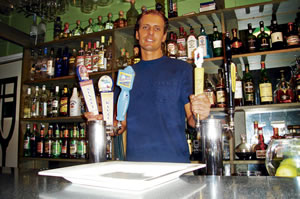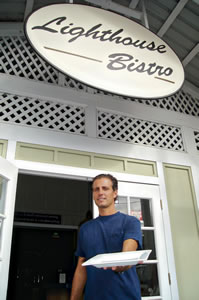Where It’s Bring Your Own Plate

For those dining in, Ernsdorf offers a variety of beverages. Coco Zickos photos
Fed up, so to speak, with Styrofoam takeout containers, Matt Ernsdorf of Kilauea Lighthouse Bistro asks folks ordering takeout to bring their own containers to get it home
Don’t forget to bring your own container if you order to go at Kilauea Lighthouse Bistro.
In an effort to reduce waste, the restaurant’s owner, Matt Ernsdorf, has banned all takeout accoutrements from his establishment. That means no cups, no containers and no plastic forks or knives.
“I feel so much better,” he says of the decision he made about five months ago. “It was like a weight lifted off my shoulders.”
With Kekaha landfill reaching capacity, and restaurants collectively responsible for generating large amounts of waste, Ernsdorf has no regrets.
Customers’ initial reactions to the idea, however, were “kind of hostile,” he admits.
People were used to calling in orders and picking up their packaged food. But they are finally starting to get the hang of it, especially when the concept of waste reduction is explained to them.
One person who is particularly fond of the change is Chef Joseph Caulfield because when food is packaged, the presentation is lost.
“It doesn’t look like how he wants it to look,” says Ernsdorf.

Styrofoam is a no-go
Now when customers place an order to go, the food is brought out to them on a plate, just as dine-in customers are served. Bypassing the kitchen and adhering to the Department of Health’s restrictions, customers are then free to place the food in their own container at their own discretion.
“So at least when they come in they get to see the plate and how the chef is putting out the food, and then they can smash it and do whatever they want,” says Ernsdorf.
Oftentimes people will just end up eating their food at the restaurant a notion Ernsdorf approves of. Having traveled throughout Europe, he enjoys experiencing patrons of dining establishments sitting down and really taking the time to enjoy their meals.
“I kind of liked that,” he says about Europe. “It’s a whole different environment. It made more sense to enjoy yourself, your company and environment.”
In the United States, food is often consumed as fast as possible, and a quick return to work is the norm.
“I want to be a restaurant where you come to sit down and enjoy yourself,” says Ernsdorf.
Takeout containers weren’t always necessary. For example, when Ernsdorf started out in the restaurant business at the age of 15, food was wrapped in foil. Aluminum turns into corrosive dust that returns to the environment.
“If it ends up in the dump, it’s going to break down,” he says.
But convenience and speed made one-time use nondegradable plastics and Styrofoam things that never sat well with Ernsdorf’s conscience take precedence in the restaurant industry. He admits that prior to the complete elimination of the products, he attempted to use biodegradable packaging. But hot food and sauces in leaky containers was less than satisfactory.
“We couldn’t do that to the food or the people,” says Ernsdorf, who has owned the restaurant since 1999.
After much research, he even discovered some of the cornbased products were manufactured with petroleum.
“To me, it just seems like a lot of marketing scam,” he says about certain biodegradables.
So everything pointed to getting rid of takeout supplies altogether.
Even Ernsdorf’s 9-year-old daughter Sweden and 5-yearold son Knight were inspirations behind his decision.
“She called me out on to-go containers before,” says Ernsdorf. “She’s trained to see from a different eye: We can change that, we don’t have to throw that away.”
Growing up in a throw-away generation, Ernsdorf appreciates the reminder he receives from his children to live more consciously.
“They can see it before we do sometimes because we’re so used to it,” he says.
Even folks who ask to take leftovers home with them are rethinking their decisions.
Lighthouse Bistro servers offer to wrap up their food in foil or explain that all leftovers are donated to pig farmers.
“As long as it’s not going in the trash, people are usually OK with it,” says Ernsdorf, a graduate of Kapa’a High School and resident of Kilauea.
Besides, patrons would typically ask for their food to be packaged and, more often than not, forget it at their tables.
“It was just spinning my wheels,” he says.
Now that the restaurant has reduced its impact, Ernsdorf is challenging others in the industry to do the same.
“I know that they’re in the same boat as me,” he says. “I really think that if they actually just thought about, they could do it too.”
And the biggest hurdle is at the start. Once a restaurant’s staff learns the right words to say, people jump on board and respect your decision to go green. Sure, more money is made when food is offered quickly.
“But at what cost?” asks Ernsdorf. “I sleep better at night knowing I’m doing what I can to reduce the waste.”



